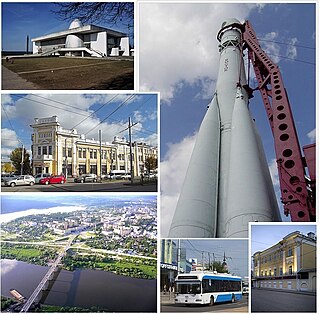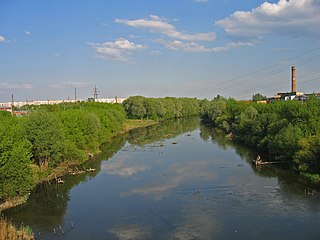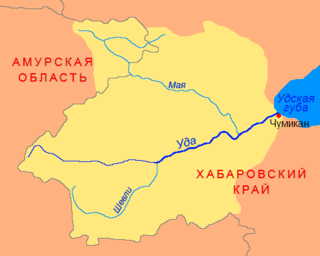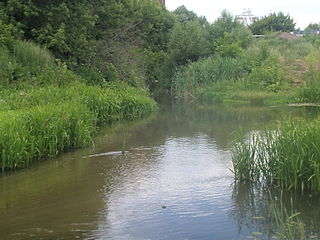Oblasts
All of oblasts′ names in Russian are based on the following model: "name of the central city" (with a few exceptions) + "-skaya" feminine adjective suffix.
| English name | Russian name | Meaning and notes |
|---|---|---|
| | Амурская область, Amurskaya oblast′ | From the Amur River, which forms the southern border of the region |
| | Архангельская область Arkhangel′skaya oblast′ | The region of the city of Arkhangelsk, whose name the inhabitants traditionally associated with a monastery in the area dedicated to the Archangel Michael. |
| | Астраханская область, Astrakhanskaya oblast′ | The region of the city of Astrakhan, whose name is a corruption of old Turkic Haji Tarkhan . Tarkhan is possibly a Turco-Mongolian title standing for "great khan," or "king", while haji or hajji is a title given to one who has made the Islamic requisite of pilgrimage to Mecca. |
| | Белгородская область, Belgorodskaya oblast′ | The region of the city of Belgorod, literally "white city". Compare: Belgrade |
| | Брянская область, Bryanskaya oblast′ | The region of the city of Bryansk, known in medieval times as Debryansk, from Old East Slavic : дъбръ, romanized: dŭbrŭ, lit. 'dense woodland' |
| | Челябинская область, Chelyabinskaya oblast′ | The region of the city of Chelyabinsk. The city (initially a Russian fortress Chelyaba) received its name after a Bashkir locality, whose etymology is disputed.
|
| | Иркутская область, Irkutskaya oblast′ | The city of Irkutsk was named after the Irkut River with -sk suffix used for names of the cities. Its name was derived from the Buryat word for "spinning," and was used as an ethnonym among local tribes, who were known as Yrkhu, Irkit, Irgit, and Irgyt. |
| | Ивановская область, Ivanovskaya oblast′ | The city of Ivanovo was previously known as Ivanovo-Voznesensk and was formed as a result of the merger of two settlements:
|
| | Калининградская область, Kaliningradskaya oblast′ | From its center Kaliningrad (Kalinin-city), renamed in 1946 in memory of the recently deceased Soviet leader Mikhail Kalinin. The region itself forms the northern part of former East Prussia. |
| | Калужская область, Kaluzhskaya oblast′ | From Old Russian kaluga - "bog, quagmire". [1] |
| | Кемеровская область, Kemerovskaya oblast′ |
|
| | Кировская область, Kirovskaya oblast′ | The city of Vyatka was renamed to Kirov soon after the assassination of Sergei Kirov, a high Soviet official who was born in the region. |
| | Костромская область, Kostromskaya oblast′ | The city of Kostroma received its name from the river it stands on. [2] Its etymology is uncertain: |
| | Курганская область, Kurganskaya oblast′ | From the city of Kurgan. Its name is taken from a burial mound close to the original settlement. The word itself has Turkic origin. |
| | Курская область, Kurskaya oblast′ | The city of Kursk was named after Kur River. The name relates to a dialect word kur'ya ("long and narrow river bay"), [3] while city's coat of arms with three partridges shows a folk etymology version of the origin of the name (Russian : куропатка, romanized: kuropatka "perdix") |
| | Ленинградская область, Leningradskaya oblast′ | The city of Leningrad (Lenin-city) was renamed back to St. Petersburg following the 1991 referendum, but Leningrad Oblast retained its name. [4] |
| | Липецкая область, Lipetskaya oblast′ | From Lipetsk, literally "Linden city" |
| | Магаданская область, Magadanskaya oblast′ | From its capital, Magadan, which etymology is uncertain: |
| | Московская область, Moskovskaya oblast′ | |
| | Мурманская область, Murmanskaya oblast′ | Murmansk, region's capital, is named for the Murman Coast (Murmanskiy bereg), which is in turn derived from an archaic term in Russian for "Norwegian". |
| | Нижегородская область, Nizhegorodskaya oblast′ | Nizhny Novgorod literally means "Lower New Town". The prefix "lower" is used to distinguish it from Veliky Novgorod ("Great New Town") and Novhorod-Siverskyi ("New Town in Severia"). Russian name for this oblast is Nizhegorodskaya (literally "of Lower Town"), and not Nizhne(-)novgorodskaya as one might expect. |
| | Новгородская область, Novgorodskaya oblast′ | Literally "Region of New Town", after its capital Veliky Novgorod, which means "Great New Town" as stated above. Before 1999 was known as just Novgorod. |
| | Новосибирская область, Novosibirskaya oblast′ | Literally "Region of New Siberian Town" |
| | Омская область, Omskaya oblast′ | The name of Omsk city is derived from the Om River which in turn is probably originates from the Baraba Tatar om "quiet". [7] |
| | Оренбургская область, Orenburgskaya oblast′ | The city of Orenburg (Or River + German : Burg "castle") was founded near the meeting of the Or and Ural rivers, but was later moved down the Ural. The initial place of the fortress became known as Orsk. |
| | Орловская область, Orlovskaya oblast′ | From Oryol, literally "eagle" |
| | Пензенская область, Penzenskaya oblast′ | City of Penza is named after Penza River, whose name possibly comes from |
| | Псковская область, Pskovskaya oblast′ | The name of the main city, originally Pleskov (historic Russian spelling Плѣсковъ, Plěskov), may be loosely translated as "[the town] of purling waters". |
| | Ростовская область, Rostovskaya oblast′ | The city of Rostov on Don originates from a fortress named for Dimitry of Rostov, a metropolitan bishop of the old northern town of Rostov the Great. The word "Rostov" is usually associated with a personal name Rost (lit. "growth"). Compare: Rostislav |
| | Рязанская область, Ryazanskaya oblast′ | The region was named after its capital, which was initially known as Pereyaslavl-Ryazansky and officially took the name of ancient city of Ryazan in 1778. The original Ryazan, the capital of medieval principality, was devastated by Mongols in 1237.
|
| | Сахалинская область, Sakhalinskaya oblast′ | This region received its name from its largest island, which name is supposed to originate from Manchu Saghalien ula anga hata "island in the mouth of Black River." Thus Sakhalin is "Black" |
| | Самарская область, Samarskaya oblast′ | Regional center Samara is named after Samara River, which etymology is uncertain: |
| | Саратовская область, Saratovskaya oblast′ | From Turkic Sary Tau "Yellow Mountain", russianized as Saratov (meaningless Sarat + -ov suffix) or Sar Atau "Boggy Island". |
| | Смоленская область, Smolenskaya oblast′ | From the city of Smolensk on Smolnya River (smola "resin" or smol′ "black soil") |
| | Свердловская область, Sverdlovskaya oblast′ | Regional center Ekaterinburg was known as Sverdlovsk in 1924–91 after the early Soviet leader Yakov Sverdlov. |
| | Тамбовская область, Tambovskaya oblast′ | The name "Tambov" originates from Moksha "томба" (tomba) meaning "abyss", [13] [14] or "deep pool". |
| | Томская область, Tomskaya oblast′ | The city of Tomsk is located on the bank of the Tom River, which name derives from Ket words tom "river" or tuma "dark, black" [15] |
| | Тульская область, Tul′skaya oblast′ | Etymology of Tula |
| | Тверская область, Tverskaya oblast′ | The name of the city of Tver is of Finno-Ugric origin, Tiheverä [16] while folk etymology traces it back to Old Russian tverd′ "fortress" (compare Polish twierdza ) |
| | Тюменская область, Tyumenskaya oblast′ | In 1586, a fortress was constructed on the site of the former Siberian Tatar town of Chingi-Tura ("city of Chingis"), also known as Tyumen, from the Turkish and Mongol word for "ten thousand" [17] – tumen. |
| | Ульяновская область, Ulyanovskaya oblast′ | The city of Simbirsk was renamed Ulyanovsk in 1924 since it was the birthplace of Vladimir Lenin, leader of October Revolution and founder of the Soviet Union, whose actual last name was Ulyanov. |
| | Владимирская область, Vladimirskaya oblast′ | The city of Vladimir was founded by the Grand Prince Vladimir II Monomakh. See Vladimir (name)#Etymology |
| | Волгоградская область, Volgogradskaya oblast′ | Volga River + -grad "town/city" = Volgograd |
| | Вологодская область, Vologodskaya oblast′ | From Old Veps valgeda (modern vauged) "white" [18] [19] |
| | Воронежская область, Voronezhskaya oblast′ |
|
| | Ярославская область, Yaroslavskaya oblast′ | The city of Yaroslavl was founded by the Grand Prince Yaroslav the Wise and named after him with addition of -l′ suffix. |

















